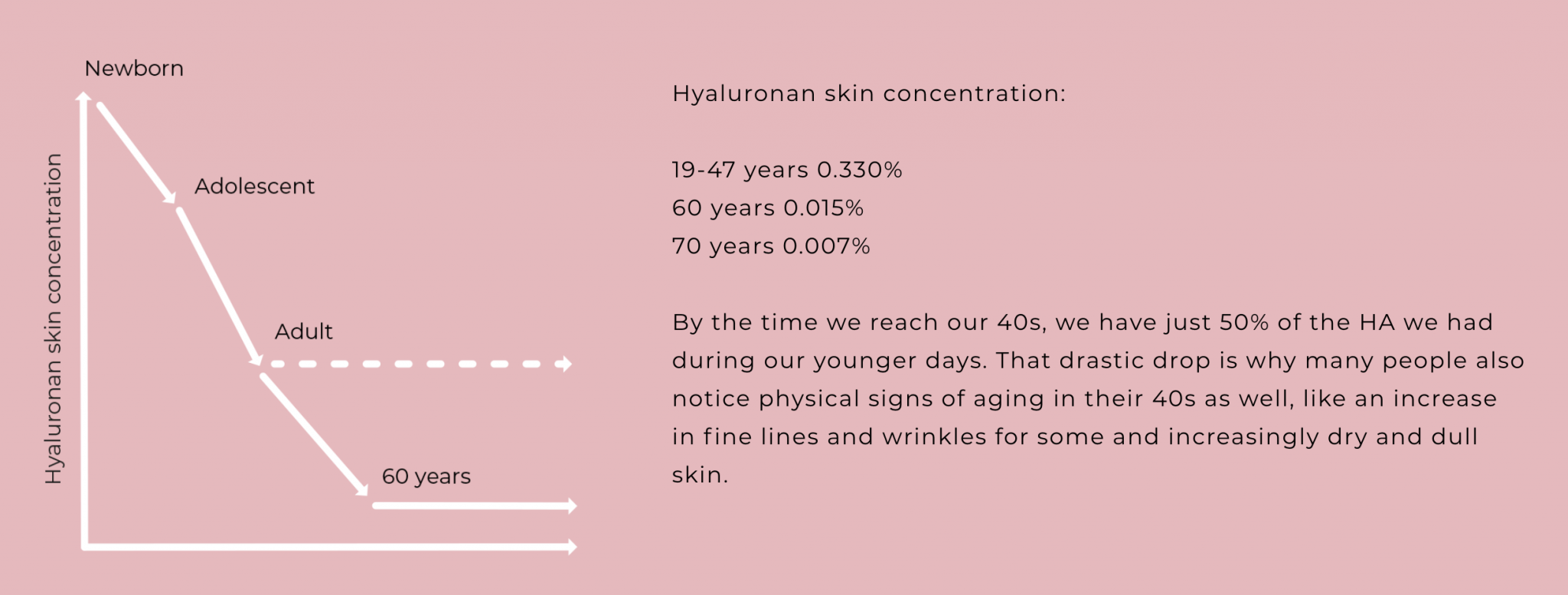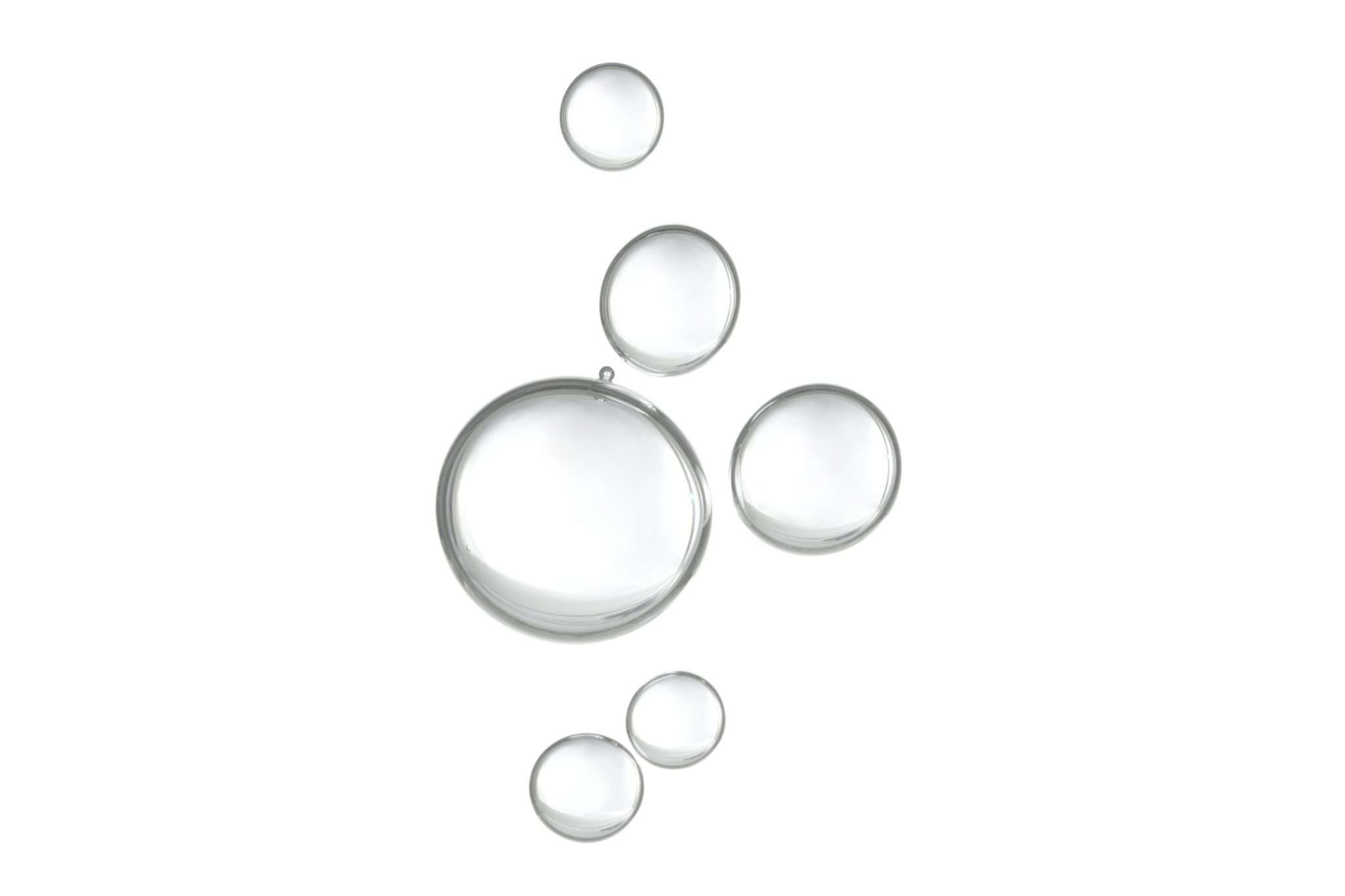
Supplementation with HLA may improve joint function, reduce wrinkles and even extend lifespan.
What is Hyaluronic Acid?
Hyaluronic acid (a.k.a. hyaluronan, HA, or HLA) is a substance naturally found in many areas of the human body including the skin, eyes, and synovial fluid of the joints.
Preserves Tissue Hydration
More than 50% of the total body content of HLA is present in the skin. (Source)It plays a key role in maintaining extracellular spaces, preserving tissue hydration, and facilitating the transport of ion solutes and nutrients to cells in the upper layer of the skin because of its water-retaining capacity. (Source)
Holds 6000x its Volume
 HLA is a humectant — a substance that retains moisture — and it is capable of binding over six thousand times its weight in water. (Source)
HLA is a humectant — a substance that retains moisture — and it is capable of binding over six thousand times its weight in water. (Source)
“HLA can bind up to 6000 times its volume in water, thus controlling tissue hydration.”
Dramatically Declines with Age
When we get older, hyaluronic acid levels in the skin decline. (Source)A 70-year-old person has 75 percent less hyaluronic acid than a 19-year-old.
The natural aging process and exposure to things like ultraviolet radiation from the sun, tobacco smoke, and pollution can decrease its amounts in the skin. (Source)
“With aging, the epidermal HLA content decreases from 0.03% in women aged 19 to 47 years down to 0.015% in women aged 60 years and halves to 0.007% in women aged 70 years.” (Source)
In Older Skin, HLA Disappears from the Epidermis

“In senile skin, HLA is still present in the dermis, while HLA of the epidermis has disappeared entirely. In addition, HLA polymers in senescent skin have a diminished ability to take on water of hydration with the consequence of a loss in skin moisture, commonly seen in aging skin.” (Source)

The most dramatic histochemical change observed in senescent skin is the marked decrease in epidermal HLA. With aging the epidermal HLA content decreases from 0,03% in women aged 19 to 47 years down to 0.007% in 70-year-old women. (Source)
Oral HLA Relieves Wrinkles in a Double-Blind, Placebo-Controlled 12-Week Study
“After 8 weeks of ingestion, the HLA group showed significantly diminished wrinkles compared with the placebo group. Skin luster and suppleness significantly improved after 12 weeks in all groups compared with the baseline. The results suggest that oral HLA inhibits skin wrinkles and improves skin condition.” (Source)
Oral Doses of High Molecular Weight HLA Migrate to the Skin

Considering the role of HLA in the skin, it is suggested that the migration of HLA to the skin acts on the wrinkled skin as follows:
There are fibroblasts in the dermis of the skin. In these fibroblasts, collagen fibers, elastin fibers, and HLA are synthesized. In vitro, HLA prompts the proliferation of fibroblasts of the dermis, and it was confirmed that intake of HLA promoted HLA synthesis in fibroblasts.

“Is is presumed that part of the orally ingested HLA promotes HLA synthesis in fibroblasts of the dermis, maintains normal skin, are is involved in the suppression of wrinkles. In addition, because the fibroblast cells are growing, it is possible to suppress wrinkles by promoting collagen synthesis. (Source)
Oral HLA Visibly Improves Wrinkles

Researchers have found HLA leads to efficacy against wrinkles, the improvement of subjective symptoms in the skin, and the improvement of skin conditions in multiple studies.
A recent study finds functionality through oral ingestion of HLA will require long-term continuous intake because the turnover for the skin is said to be 28 days. (Source)
“It was confirmed that HLA is safe in humans when 200 mg/day HLA was ingested for 12 months; a long-term ingestion.”
Overall, intake of HLA over a longer period of time seems to have a positive impact on skin health.
Reduces Pain Due to Osteoarthritis

A number of trials have demonstrated that oral HLA intake improves symptoms of osteoarthritis. (Source)
A randomized, double-blinded, placebo-controlled trial carried out between 2008 and 2015 has proven the effectiveness of HLA for the treatment of symptoms associated with synovitis, and particularly, knee pain, relief of synovial effusion or inflammation, and improvement of muscular knee strength.
Oral Delivery of HLA Improved Knee Pain in Older Adults
Oral administration of HLA may improve the symptoms of knee osteoarthritis in patients aged 70 years or younger when combined with the quadriceps strengthening exercise. (Source)According to this review, oral HA supplementation is effective in relieving osteoarthritis pain, synovial effusion, or inflammation, and improving muscular knee strength.
Greater Absorption with Liposomal Hyaluronic Acid

As HA is a big molecule, there have been some speculations about whether it can be absorbed.
Traditional HLA Supplements Degrade Quickly
Orally administered HLA typically show low absorption, or bioavailability, due to their degradation by enzymes in the gastrointestinal (GI) tract, the difficulty of absorbing them in the small intestine, and the first-pass metabolism in the liver.
“The most important limitations of HA are due to its short half-life and quick degradation in vivo and its consequently poor bioavailability.” (Source)
Liposomal HLA Directly Absorbed
 Liposomes likeness to our living bilayer lipid cell membranes has a clear advantage for absorbing dietary supplements. Creating this molecular mimicry allows our body to use its own mechanisms to directly absorb HLA into the tissue. (Source)Liposomes likeness to our living bilayer lipid cell membranes has a clear advantage for absorbing dietary supplements. Creating this molecular mimicry allows our body to use its own mechanisms to directly absorb HLA into the tissue. (Source)
Liposomes likeness to our living bilayer lipid cell membranes has a clear advantage for absorbing dietary supplements. Creating this molecular mimicry allows our body to use its own mechanisms to directly absorb HLA into the tissue. (Source)Liposomes likeness to our living bilayer lipid cell membranes has a clear advantage for absorbing dietary supplements. Creating this molecular mimicry allows our body to use its own mechanisms to directly absorb HLA into the tissue. (Source)
How do HLA Liposomes Work?
When the liposome merges with the lipid bilayer of the cell membrane, it can deliver its contents directly to the cell. Liposomes are designed not only to protect the nutritional supplement from degrading and absorbing in the harsh environment of the gut terrain, but also to deliver the nutrients in a targeted manner to specific tissues and areas of the body.
Anti-inflammatory and Radical Scavenging Properties of HLA
HLA counteracts aging processes by its anti-inflammatory and radical scavenging properties. It can both be protective as a free radical scavenger and at the same time be a target for free radial stress. because it is itself harmed by the more toxic free radicals. (Source)
HLA Longevity Benefits
 Hyaluronic acid contains acetyl-glucosamine, a substance that extends lifespan in organisms. (Source)Acetyl-glucosamine can reduce protein accumulation—a key driver of the aging process.Scientists believe that acetyl-glucosamine can extend lifespan by reducing protein accumulation and inducing a cellular repair response. (Source)
Hyaluronic acid contains acetyl-glucosamine, a substance that extends lifespan in organisms. (Source)Acetyl-glucosamine can reduce protein accumulation—a key driver of the aging process.Scientists believe that acetyl-glucosamine can extend lifespan by reducing protein accumulation and inducing a cellular repair response. (Source)
References
Ingestion of an Oral Hyaluronan Solution Improves Skin Hydration, Wrinkle Reduction, Elasticity, and Skin Roughness: Results of a Clinical StudyHyaluronic acid and skin: wound healing and agingOral hyaluronan relieves wrinkles: a double-blinded, placebo-controlled study over a 12-week periodOral administration of polymer hyaluronic acid alleviates symptoms of knee osteoarthritis: a double-blind, placebo-controlled study over a 12-month period.Use of Lipid Nanocarriers to Improve Oral Delivery of VitaminsAcetylated Hyaluronic Acid: Enhanced Bioavailability and Biological StudiesOral Hyaluronan Relieves Knee Pain: A ReviewPharmaceutical liposomal drug delivery: a review of new delivery systems and a look at the regulatory landscapeHyaluronan (Hyaluronic Acid): A Natural Moisturizer for Skin CareAge-related Changes in Pericellular Hyaluronan Organization Leads to Impaired Dermal Fibroblast to Myofibroblast DifferentiationEfficacy and absorption of hyaluronic acid and N-acetyl-D-glucosamine for the treatment of osteoarthritisOral collagen supplementation for skin aging: A fad or the future?Ingested hyaluronan moisturizes dry skinAge-dependent changes of hyaluronan in human skinAre hyaluronan receptors involved in three-dimensional cell migration?Adapting liposomes for oral drug deliveryHexosamine Pathway Metabolites Enhance Protein Quality Control and Prolong LifeN-Acetylglucosamine Functions in Cell Signaling
